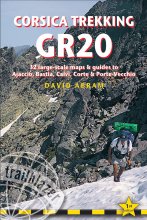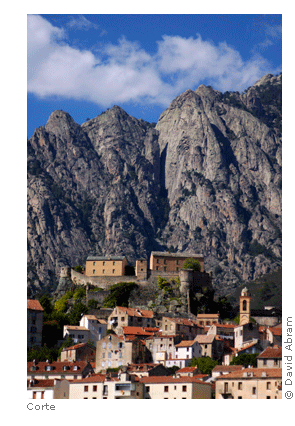Worth watching out for.
— John Cleare

Corsica Trekking GR20
Excerpt:
Route options
Contents | Introduction | Independently or with a group? | Route options | Practical information for the visitor | Sample route guide

One of the curious things about the GR is that seemingly everyone – whether they're doing the route in five days or sixteen, with or without a tent, from the north or the south, alone or in a group – thinks their style is the way to go.
Ultimately, of course, the best way is the way which most suits you and it pays to find out what that is early on.
To a large extent fitness will determine how much you can take on each day. don't overstretch yourself. If your schedule means you have to double up days, ensure you combine easy, short ones rather than long étapes involving tough climbs.
Above all, try not to be swept along by others walking at a faster pace than you're comfortable with, merely to arrive at Conca a day or two ahead of time.
One thing lots of trekkers regret after they've finished the route is that they didn't attempt one or more of the hugely rewarding side trips.
Some of these, notably the waymarked trails up the big summits flanking the GR, take you into truly awesome landscapes that are a step up in every sense from what you experience along the main path.
Bear in mind that some optional routings, such as the Variante over Monte Renoso (see p168), are far more inspiring than their lower-level equivalents (which were originally envisaged only as poor-weather alternatives).
The majority of those who complete all 16 stages do so in 10 to 12 days. Do it any quicker and you'd have to be doubling or tripling up lengthy étapes.
Take any longer and you'll have plenty of time for detours and for lazing around on the high spots. it's amazing how many people race off at dawn to arrive at the refuge by lunchtime when they could be enjoying sublime scenery up on the trail.
Also worth considering are itineraries that tie together sections of the GR20 with sections of the other long-distance routes.
Two of these – the Mare a Mare Nord (and its variant) and the Tra Mare e Monti – intersect the GR, giving access to radically different coastal or valley scenery and villages.
Following them, even if only for a few stages, will give you a far more rounded picture of the island than you'd get from just the GR20.
With less time, say around one week, you might opt to cover certain sections of the GR20. From Calenzana, Castel di Verghio is easily reachable in five days.
With six to seven days you could press on to Corte via the Mare a Mare Nord via the Tavignano Gorge. This would take you through the most rugged and toughest stretches of the GR20 route, where the landscape is at its most spectacular.
Alternatively, pick up the trail at Vizzavona, from where you can cover the more restrained (and correspondingly easier) southern section to Conca in six days.
NORTH OR SOUTH?
Many trekkers follow the Grande Randonn�e from south to north, ie in the reverse direction to that described in this book.
The advantage is that you begin with the least strenuous étapes and build up to the more gruelling ones.
On the other hand, walking northwards will present you with the more subdued, sun-blasted south faces of the massifs rather than the eternal snows and darker crags of their northern slopes.
The waymarking is equally dependable in both directions.
Ultimately you might end up following the trail from south to north just because your flight landed at Figari Airport, from where Conca is far more accessible than Calenzana.
To avoid confusion, stage timings on our maps are given only from north to south.
Latest tweets